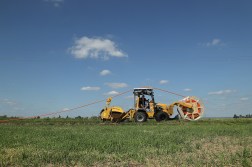California nonprofit, libraries team up to use federal funds to expand broadband service

CRYSTAL CITY, Va. — A telehealth nonprofit is now hoping to use a unique partnership with several public libraries to bring high-speed internet to a Southern California community in desperate need of better broadband service.
The California Telehealth Network is currently reviewing proposals from companies hoping to help them expand high-speed internet access for nine health care facilities and three libraries in the Kern River Valley, a rural region of roughly 15,000 people just outside Bakersfield.
The project’s architects believe the effort is the first of its kind in the way it uses federal funding from two different sources. Here at the School, Health and Libraries Broadband Coalition’s annual conference Thursday, leaders with the telehealth network and its partners detailed how the libraries plan to secure funds from the Federal Communication Commission’s E-Rate program for the project to supplement the network’s federal dollars from the FCC’s “Healthcare Connect Fund.”
“What we’re trying to do here in California is use the Kern River Valley as a template for the other 41 communities we know are broadband unserved around the state,” said Eric Brown, president and CEO of the telehealth network, which works with hundreds of healthcare providers around the state on broadband access issues.
Indeed, Jim Rogers — president of HealthConnect Networks, a consulting firm working with the nonprofit on the effort — said the Kern River Valley stood out among the underserved communities they examined. Not only is it larger than many of the regions around the state lacking broadband access, but he said the area lacked any fiber infrastructure of any kind.
[Read more: Midwestern schools, libraries missing out on millions in broadband funds from FCC]
With three public libraries in the region itching to get connected, Rogers said it seemed like a natural fit to partner with those groups. Brown noted that the telehealth network has a partner organization with lots of experience applying for funds through the E-Rate program — which the FCC uses to help get schools and libraries get more connected — so his group was able to help the libraries navigate its complexities.
Simultaneously, Brown’s network crafted a design for the program that would be compliant with the strictures of both FCC funds.
“It was definitely a challenge figuring out the mechanics of how to get those applications submitted and how the respective programs share the cost,” said Jeff Mitchell, a lawyer with the telecom-focused firm Lukas, Nace, Gutierrez & Sachs who provided counsel on the project.
Once the groups drafted the paperwork, they cobbled together a request for proposals in February. Rogers noted the solicitation didn’t prescribe a solution for the mechanics of the new network — while the plan is to connect the community to infrastructure owned by AT&T outside the region, they’re flexible about how companies make that a reality.
Rogers thinks it’s “likely” that the telehealth network will end up working with a firm to build the network and then own it, but leave maintenance responsibilities to the vendor. Yet he noted that the RFP also allowed for companies to propose solutions involving leasing their infrastructure to the nonprofit, or even some combination of those strategies.
The network stopped accepting proposals on March 20. Rogers said they received interest from “several bidders” and they’re working through the process of scoring them.
While the project depends on FCC approval to get off the ground, making it unclear when work can begin, all involved are optimistic that it can become a reality and get more of California connected.
“If these facilities were commercially viable, they would’ve been built a long time ago,” Mitchelll said. “But now, we’ve got a high degree of involvement of state stakeholders supporting the effort as well.”
Contact the reporter at alex.koma@statescoop.com, and follow him on Twitter @AlexKomaSNG.






